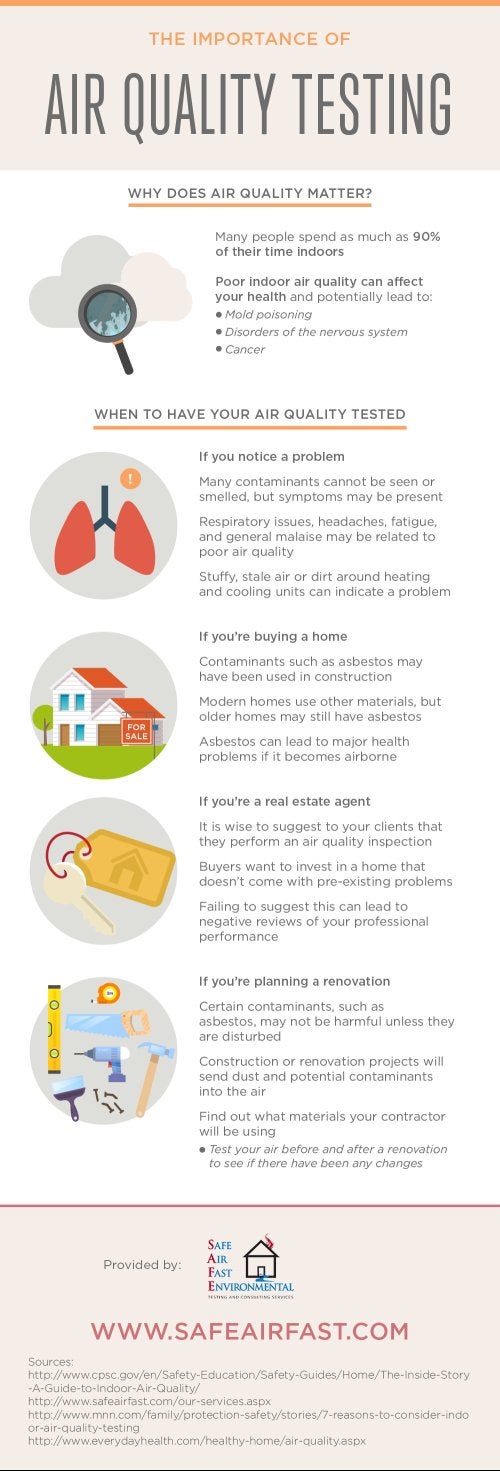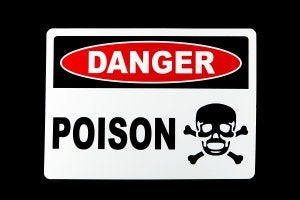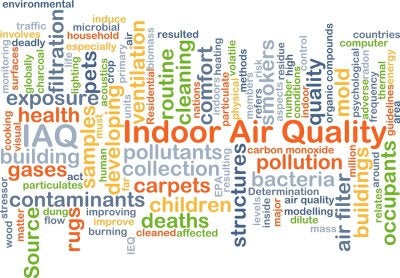-
The Importance of Air Quality Testing [Infographic]
Did you know that many people spend as much as 90 percent of their time indoors? If you have noticed signs of poor air quality such as respiratory issues, allergies, headaches, and fatigue, contact the professionals for a test of your indoor air quality in San Francisco . Though mold may be visible or give off a noticeable smell, there are other contaminants such as lead and asbestos that are much more difficult to detect on your own. If you are in the home-buying process or getting ready for a renovation project, have your air quality tested to find out what you might be getting into. Check out this infographic to learn more about why indoor air quality testing is essential, and when to have it done. Please share with your friends and neighbors.

-
The Dangers of Asbestos
Are you worried that you may have asbestos symptoms in San Francisco? If you think you have been exposed to asbestos in your home, it’s essential that you schedule a professional asbestos test. Watch this video to learn about the dangers of asbestos exposure.
Asbestosis is a chronic condition characterized by scarring and inflammation of the lung tissue. This disease progressively worsens over time and causes coughing, shortness of breath, and permanent lung damage.
Mesothelioma, a cancer of the tissue lining body cavities, most commonly in the chest and abdomen, is almost always caused by asbestos exposure. Mesothelioma is incurable, and life expectancy after diagnosis is short.
-
Understanding the Symptoms of Lead Poisoning
If you’re concerned that your home may have lead paint in San Francisco, it’s vital that you schedule professional lead paint testing to ensure the health of you and your family. Lead based paint is commonly found in older buildings and is the most common cause of lead poisoning in children. Small amounts of lead buildup in the body can lead to serious health problems, and higher levels can be fatal.
Sources of Lead Poisoning Symptoms

It can take months of exposure before symptoms of lead poisoning manifest, making it difficult to detect. A person with high amounts of lead in their blood can appear healthy, and may not seem sick until their body has accumulated dangerous amounts of lead. Adults can suffer from lead poisoning, but children under the age of six are particularly vulnerable. While lead paint is the most common source of lead poisoning for children, adults who work with batteries or in construction can be exposed to hazardous levels of this toxin.
Lead Poisoning Symptoms in Children
Young children have a higher risk for lead poisoning because they frequently put their hands and objects in their mouths, and sometimes swallow non-edible items. At this age, children’s brains are developing rapidly, and their bodies absorb lead quickly. Symptoms of lead poisoning in children can include vomiting, weight loss, irritability, fatigue, abdominal pain, and constipation. Children affected by lead poisoning are also susceptible to hearing loss, learning problems, and developmental delay. Infants exposed to high amounts of lead can suffer slowed growth and learning disabilities.
Lead Poisoning Symptoms in Adults
Adults who have accumulated dangerous amounts of lead in their bloodstream can experience headaches, joint pain, abdominal pain, constipation, and muscle pain. Long-term and more severe symptoms include high blood pressure, hindered mental function, mood disorders, memory loss, and reduced sperm count or abnormal sperm. Exposure to lead can also cause premature birth or miscarriage in pregnant women.
-
Indoor Air Quality 101
Does your home need mold testing or to be inspected for asbestos and lead paint in San Francisco? Your indoor air quality depends on your home being free of these harmful materials, and can also be affected by airborne particles, gasses, chemicals, moisture level, and temperatures.
Poor indoor air quality can affect the health of you and your family. Mold can contribute to allergy and asthma symptoms, and asbestos exposure can lead to lethal cancers. The air quality in your home also affects the structure of your home and its value. High moisture levels can promote the growth of mold and bacteria, as well as invite wood-damaging pests into your home.
If you’re concerned about the air quality in your home, call a professional mold testing company today. Safe Air Fast provides high-quality inspection services for testing your home or office for lead, asbestos, mold, and bacteria. We offer the best testing quality in the industry.

-
A Look at FAQs About Asbesto
People who are familiar with diseases like mesothelioma are commonly worried about asbestos exposure in San Francisco. The EPA and CPSC have banned the use of most asbestos products in construction, but cutting or disturbing materials that contain these harmful fibers can lead to severe health issues. If you suspect your home may have asbestos, schedule a professional asbestos test before beginning any home improvement projects.
What is Asbestos?

Asbestos is a mineral fiber that was used in a variety of construction materials beginning in the early 1900s and up until the late 1970s. Asbestos was also used by most branches of the U.S. Armed Forces as insulation for vehicles, ships, and aircraft. The name asbestos describes a group of naturally occurring mineral silicates that crystallize into bundles of thin filaments. Asbestos cannot be identified visually and must instead be sampled, tested, and analyzed by a qualified professional.
How Can I Be Exposed to Asbestos?
Areas in proximity to asbestos mines can have higher concentrations of asbestos particles in the air due to weather and erosion inside the excavation tunnels. However, most people suffer asbestos exposure when nearby asbestos-containing construction materials are disturbed in some way. Drywall, insulation, floor and ceiling tiles, paint, and cement are just a few of the products that were once made using asbestos fibers. Asbestos exposure typically occurs after inhaling contaminated air.
What are the Health Effects of Asbestos Exposure?
When asbestos fibers are inhaled, most of them are removed through exhalation and coughing. If the body’s defenses fail to eliminate all of the fibers from the lungs, inflammation and scarring caused by the trapped particles can lead to decreased lung function. Long-term exposure to asbestos can cause lung cancer, mesothelioma cancer, asbestos cancer, asbestosis, lung disease, or chronic obstructive pulmonary disease. In most cases, it takes as long as 20 or 30 years for the harmful effects of asbestos exposure to manifest. Today, approximately 2,000 to 3,000 Americans are diagnosed with mesothelioma annually, and the same number die each year due to asbestos-related lung cancer.
RECENT POSTS
categories
- Uncategorized
- Lead
- Mold
- San Francisco Mold & Asbestos Removal
- Indoor Air Pollution
- Mold Remediation
- Asbestos
- Safe Air Fast
- Mold Inspection
- Remediation
- Bacteria Testing
- Asbestos Testing
- Abatement
- Lead Testing
- Sewer Line
- Lead Survey
- Mold Testing
- Air Quality Inspection
- Home renovations
- Allergies
- Renovation Contractor
- Infographic
- lead paint
- Air Quality
- Air Quality Test
- Mold removal
